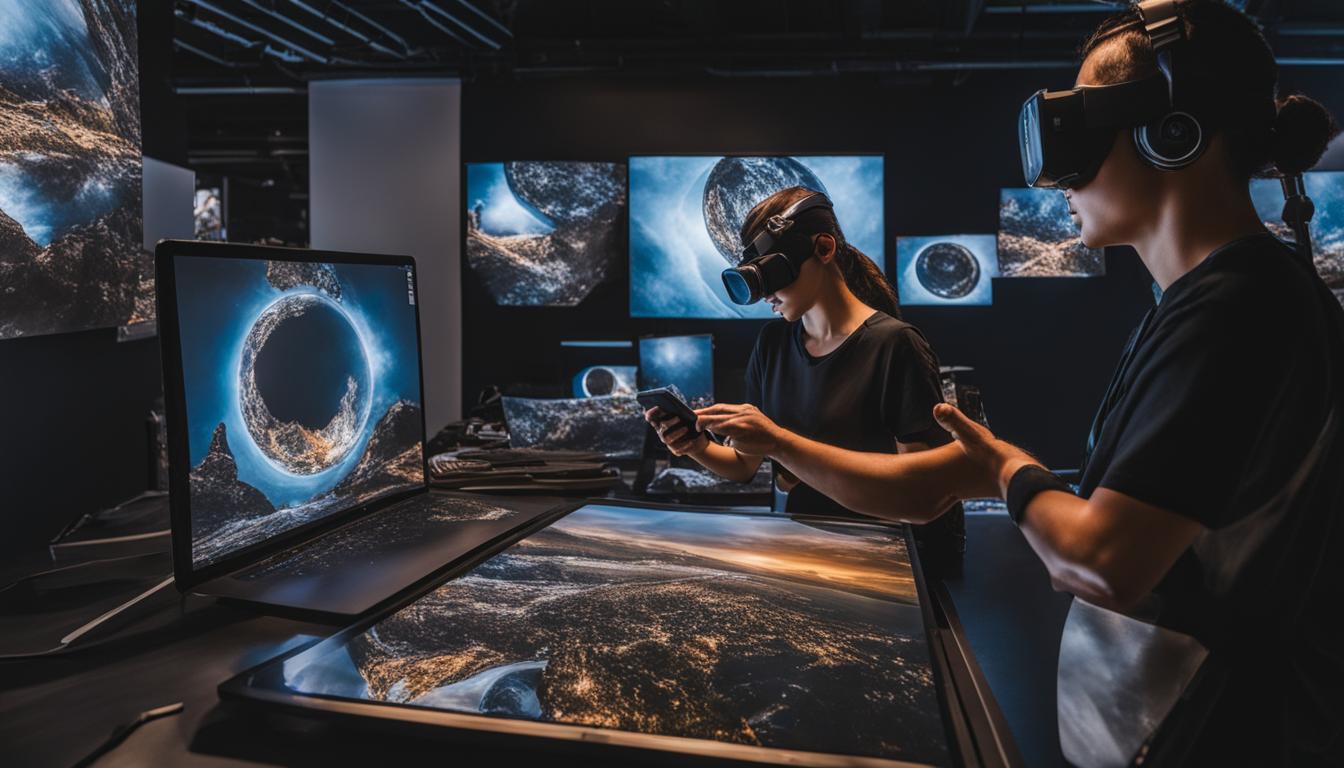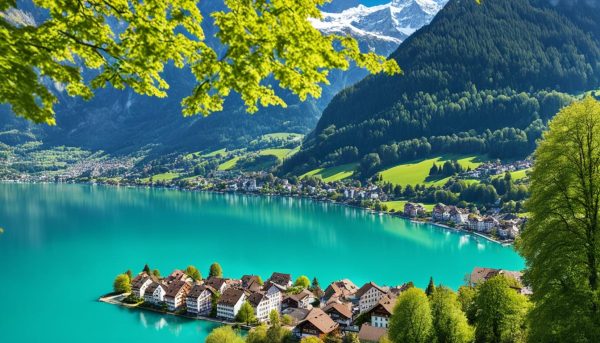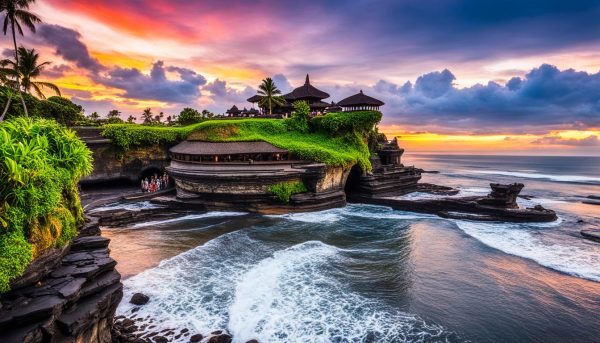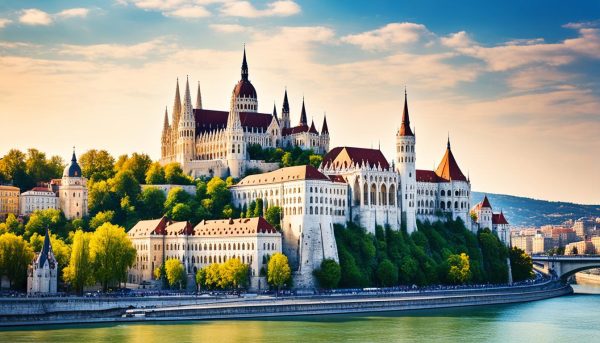Photography has come a long way since the invention of the camera in the 19th century. Today, the future of photography is being shaped by emerging trends and technologies that are changing the way we perceive and create visual content.
As technology continues to advance, photographers are exploring new possibilities, from smartphone photography to virtual reality. The future of photography is exciting and full of potential, and it’s essential to stay up-to-date with the latest trends and technologies to stay ahead in the game.
Key Takeaways
- The future of photography is being shaped by emerging trends and technologies.
- Advancements in smartphone photography, artificial intelligence, and virtual reality are changing the way we capture and share images.
- Photographers are embracing sustainable practices to address the environmental impact of their work.
- Social media platforms have created new opportunities for photographers to share their work and connect with audiences.
- The rise of drone photography and aerial perspectives has revolutionized the field of photography.
Advancements in Smartphone Photography
Smartphone technology has come a long way, and so has smartphone photography. With features such as dual-lens cameras, portrait mode, and optical zoom, smartphones are increasingly capable of taking high-quality photos.
Photography apps have also played a significant role in expanding the possibilities of smartphone photography. These apps allow users to adjust exposure, adjust focus, add filters, and even shoot in raw format. Popular photography apps such as VSCO, Snapseed, and Adobe Lightroom CC have become go-to tools for many mobile photographers.
Mobile editing has also become more sophisticated, enabling users to retouch photos on their smartphones with ease. From basic adjustments such as brightness and contrast to advanced features such as selective adjustments and healing tools, mobile editing apps have made it possible to produce professional-quality images on the go.
Furthermore, the convenience and immediacy of smartphone photography have made it an increasingly popular medium for sharing images on social media platforms such as Instagram and Facebook. The ability to capture and share images instantly has resulted in a new kind of visual storytelling, one that is fast-paced, dynamic, and highly engaging.
Overall, smartphone photography, photography apps, and mobile editing have transformed the way we capture and share images. As smartphone technology continues to evolve, it is exciting to imagine the possibilities that lie ahead for smartphone photography.
Rise of Mirrorless Cameras
Mirrorless cameras have emerged as a serious competitor to the traditional Digital Single-lens Reflex (DSLR) cameras in recent years. Mirrorless cameras utilize a different technology that eliminates the bulky mirror found in DSLRs, making them lighter and more compact. Their smaller size, excellent image quality, and superior video capabilities are some of the factors responsible for their increasing popularity.
The absence of a mirror in mirrorless cameras means the camera body can be smaller, making it easier to travel with and carry around for extended periods without causing fatigue. Moreover, due to their electronic viewfinder, rather than optical viewfinders found in DSLRs, mirrorless cameras offer photographers a more accurate representation of the image they will capture. Additionally, they allow for silent shooting, which is useful in environments where noise is inappropriate.
| Advantages of Mirrorless Cameras | Disadvantages of DSLRs |
|---|---|
| Smaller and more compact | Bulky and heavy |
| Superior video capabilities | Limited video capabilities |
| More accurate representation of final image with electronic viewfinder | Optical viewfinder can be less accurate |
| Ability for silent shooting | Noisy shutter sound |
The rise of mirrorless cameras has pushed DSLR manufacturers to adapt and improve their products, resulting in the development of high-end DSLRs with innovative features. Nevertheless, mirrorless cameras are more accessible to hobbyist photographers and have laid the foundation for future camera technology.
The future of camera technology is likely to be dominated by mirrorless cameras, as they continue to push the boundaries of what is possible in photography.
Artificial Intelligence in Photography
Artificial Intelligence (AI) has made its way into the world of photography, and the results are impressive. AI algorithms are now being incorporated into camera systems to enable automatic settings and enhance image quality.
Automatic settings, powered by AI, allow photographers to capture images quickly and accurately. For example, the camera can detect the lighting conditions and chose the best settings for the shot. This feature takes the guesswork out of photography and allows even beginners to capture stunning images.
Furthermore, AI-powered image processing can enhance image quality by reducing noise, sharpening details, and improving colors. With these capabilities, AI is transforming the way photographers approach their craft, enabling them to achieve better results in less time.
“AI is transforming the way photographers approach their craft, enabling them to achieve better results in less time.”
AI also has the potential to revolutionize image search. With AI-powered image recognition, photographers can search for specific images based on the content of the image. For example, a photographer could search for “beach” or “sunset” and quickly find all the images in their library that match those criteria.
As AI continues to evolve, we can expect even more exciting developments in the field of photography. From automatic settings to advanced image processing and beyond, AI is helping photographers capture and create stunning images like never before.
Virtual Reality and Photography
Virtual Reality (VR) has opened up new possibilities for photographers to create immersive experiences. By using VR technology, photographers can transport viewers to different environments, creating a sense of presence and interactivity that was previously unavailable. From virtual exhibitions to interactive photo essays, VR is an exciting new medium for visual storytelling.
Immersive Experiences
One of the most exciting aspects of VR technology is the ability to create fully immersive experiences. By using specialized cameras and software, photographers can capture 360-degree panoramas that allow viewers to explore a location as if they were physically present. This type of immersive experience is particularly well-suited to travel photography, where viewers can feel as if they are visiting a new place without leaving their homes.
Interactivity and Engagement
VR also allows for a new level of interactivity and engagement with photography. By integrating interactive elements into their VR experiences, photographers can create fully-realized worlds that viewers can explore and interact with. This could include interactive photo essays where users can click on different elements for more information, or virtual exhibitions where users can walk around and examine the photos at their leisure.
Future Possibilities
The future of VR and photography is full of exciting possibilities. As the technology continues to develop, we can expect to see even more immersive and interactive experiences that push the boundaries of what is possible with traditional photography. From virtual reality travel experiences to interactive documentaries, the possibilities are endless.
Augmented Reality in Photography
Augmented reality (AR) is a technology that superimposes digital content onto the physical world. In photography, AR is being used to create interactive experiences that enhance visual storytelling. By overlaying digital information onto a camera’s viewfinder or a printed image, AR enables photographers to create immersive experiences that engage viewers in new and exciting ways.
AR can be used in a variety of ways in photography. For example, it can be used to add contextual information to a photo, such as the location or time of day. This can help to create a more complete and meaningful story for the viewer. AR can also be used to create interactive elements within a photo, such as animations or sound effects.
One of the key benefits of using AR in photography is the ability to create a deeper level of engagement with viewers. By adding interactive elements to a photo, photographers can encourage viewers to spend more time exploring the image and engage with it in a more meaningful way.
AR technology is still in its early stages, but it has the potential to transform the way we think about visual storytelling. By incorporating AR into their work, photographers can add new dimensions to their images and create truly immersive experiences for their audience.
“AR technology is still in its early stages, but it has the potential to transform the way we think about visual storytelling.”
3D Photography and Depth Sensing
Advancements in 3D photography and depth sensing technologies have added a new dimension to the art of photography. With 3D imaging, a photo can depict depth and create an illusion of being three-dimensional, even though it is a two-dimensional image. This technique is useful in various fields, such as architecture, product design, and entertainment.
Depth sensing technology utilizes various methods, including structured light, time-of-flight, and stereoscopic vision, to measure the distance between the camera and the subject. This technology enables the camera to calculate the depth-of-field of the image, allowing photographers to control the foreground and background blur for creative effect.
One of the significant advantages of 3D photography and depth sensing is the ability to capture real-life objects and create virtual replicas. This technology has found practical applications in fields such as medicine, where it is used to develop accurate 3D models of organs for diagnosis and treatment purposes.
Computational Photography: Enhancing Images with Algorithms
In recent years, computational photography has emerged as a powerful tool for enhancing image quality and creating unique effects. This technique combines hardware and software to process images, using sophisticated algorithms to produce stunning results.
Image processing and algorithms
Image processing is a key element of computational photography, applying mathematical operations to digital images to enhance their quality and appearance. Algorithms are the programming instructions used to carry out these operations. Some common algorithms used in computational photography include:
| Algorithm | Function |
|---|---|
| HDR (High Dynamic Range) | Combines multiple images with varying exposures to capture more detail and a wider range of colors and tones. |
| Image stacking | Superimposes multiple images to create a single, sharper image with reduced noise. |
| Noise reduction | Reduces the appearance of digital noise, resulting in smoother, cleaner images. |
These algorithms can be used alone or in combination with one another, offering photographers a wide range of creative options for enhancing their work.
Advantages of computational photography
One of the main advantages of computational photography is its ability to create effects that would be difficult or impossible to achieve with traditional photography techniques. For example, HDR can capture a wider range of colors and tones than a single image, while image stacking can create a sharper, more detailed image. Computational photography can also reduce the amount of equipment needed for a shoot, allowing photographers to travel light and capture stunning images on the go.
Additionally, computational photography can help photographers overcome technical challenges such as low light conditions or shaky hands. For example, some smartphones now offer automatic image stabilization, while others use algorithms to enhance low-light images.
Furthermore, computational photography can improve the speed and efficiency of the image capture and editing process. Automatic settings, made possible by sophisticated algorithms, can help photographers capture great shots quickly and easily, while advanced image processing tools can reduce the time and effort required to edit and enhance images.
As computational photography continues to evolve, it is likely to transform the art and practice of photography in ways we can only imagine. By harnessing the power of image processing and algorithms, photographers can create stunning images that push the boundaries of what is possible.
Sustainability in Photography
As photographers, we have a responsibility to protect the environment. Sustainable photography is about capturing beautiful images while minimizing our environmental impact. Here are some eco-friendly practices that photographers can adopt to reduce their carbon footprint:
- Use rechargeable batteries instead of disposable ones.
- Print on recycled paper and use eco-friendly inks.
- Avoid over-packaging and use sustainable materials for transportation.
- Shoot locally to minimize travel and carbon emissions.
- Choose equipment with minimal environmental impact.
- Donate or recycle old equipment instead of throwing it away.
But sustainable photography is not just about minimizing environmental impact. It’s also about using our craft to raise awareness about environmental issues. Photographers have the power to tell stories and inspire change. By capturing the beauty of nature and the impact of human activity on the environment, we can raise awareness and urge action.
“Photography is a way of feeling, of touching, of loving. What you have caught on film is captured forever… It remembers little things, long after you have forgotten everything.” – Aaron Siskind
Photography has the power to evoke emotions, spark conversations, and inspire change. Sustainable photography allows us to make a positive impact on the environment and society. By using eco-friendly practices and telling stories that matter, we can create a better and more sustainable world.
Drone Photography and Aerial Perspectives
The rise of drone photography has revolutionized the way we capture and experience aerial perspectives. With the ability to fly and capture stunning images from above, drone photography has opened up new creative possibilities for visual storytelling.
Whether you are shooting landscapes, architecture, or events, the unique aerial perspectives that drones offer can add a new dimension to your work. From the sweeping views of mountains and valleys to the vibrant colors of cityscapes, drone photography can help you create breathtaking images that stand out from the crowd.
With advancements in drone technology, drones are now more accessible and easy to use than ever before. Many drones come with high-quality cameras that allow you to capture high-resolution images and videos from above. In addition, drone pilot training and certification programs are available to ensure safe and responsible drone use.
While drone photography offers exciting possibilities, it also requires careful planning and preparation. Before taking your drone out for a flight, it is important to research local regulations and obtain any necessary permits. You should also carefully consider the weather conditions and the location where you will be flying.
In addition, be sure to respect people’s privacy and avoid flying over restricted areas such as airports, military bases, and national parks. As responsible drone pilots, it is up to us to ensure that we use this technology in a safe and ethical manner.
Tips for Capturing Great Drone Photography Shots
- Experiment with different camera settings to capture the best images in different lighting conditions.
- Use the rule of thirds to compose your shots and create visually balanced images.
- Try to capture unique perspectives and angles that are not possible from the ground.
- Explore different shooting modes such as panorama and time-lapse to add variety to your drone photography.
By incorporating drone photography into your work, you can create striking visuals that capture the beauty and complexity of the world around us. So why not take flight and explore the possibilities of drone photography for yourself?
The Role of Social Media in Photography
Social media platforms have transformed the way photographers share their work, connect with the photography community, and engage with audiences. With billions of users worldwide, social media is an essential tool for photographers to showcase their skills, gain exposure, and build their brand.
Visual storytelling is at the heart of social media, with platforms such as Instagram, Pinterest, and Snapchat providing a dynamic canvas for photographers to display their work. Through visually stunning images and creative captions, photographers can convey their vision, share their experiences, and connect with their audience on a personal level.
“Social media is a valuable resource for photographers to gain exposure and build their brand. It allows us to showcase our work to a global audience and connect with like-minded individuals, creating a vibrant community of creatives.”
The photography community has thrived on social media, with platforms such as Reddit and Flickr providing online forums for photographers to exchange ideas, share feedback, and collaborate. Social media has also facilitated the rise of niche photography communities, focused on specific genres such as street photography, landscape photography, and wildlife photography.
Instagram, in particular, has become a hub for photographers, with its Explore feature showcasing curated content based on individual user interests. This has led to a democratization of photography, with emerging photographers gaining exposure alongside established professionals.
Visual Storytelling on Social Media
Visual storytelling is a powerful tool for photographers, enabling them to convey their message, evoke emotions, and connect with their audience. Social media has revolutionized visual storytelling, providing a dynamic platform for photographers to share their work and build a loyal following.
One of the key aspects of visual storytelling on social media is authenticity. Audiences respond to genuine, honest, and transparent content, and photographers who share their personal experiences and struggles can create a deeper connection with their audience.
Moreover, social media provides photographers with the opportunity to experiment with different styles, techniques, and compositions, enabling them to push the boundaries of their craft and develop their creative voice.
Connecting with the Photography Community
Social media has connected photographers from around the globe, creating a vibrant community of creatives. Through online forums, groups, and chats, photographers can exchange ideas, share feedback, and collaborate on projects.
Moreover, social media provides the opportunity to participate in photography challenges, contests, and exhibitions, opening up new avenues for exposure and recognition. This has created a sense of camaraderie and competition within the photography community, driving photographers to push their limits and elevate their work.
Conclusion
In conclusion, the future of photography is an exciting one with emerging trends and technologies shaping the industry. From advancements in smartphone photography to the rise of mirrorless cameras, artificial intelligence, and virtual and augmented reality, photographers have a wealth of creative possibilities to explore.
Sustainability Matters
It is also important to note that photographers are increasingly adopting sustainable practices to address environmental concerns related to the craft. By embracing eco-friendly approaches, the photography community can minimize their environmental impact and contribute positively to the world around them.
Social Media and the Future
Social media is also playing a significant role in shaping the future of photography, providing new avenues for photographers to share their work and connect with audiences. It has become an influential platform for visual storytelling and building a photography community.
Overall, by embracing these innovations and sustainable practices, the photography community is poised for an exciting future filled with endless possibilities.
FAQ
What are the emerging trends and technologies shaping the future of photography?
The future of photography is being shaped by advancements in smartphone photography, the rise of mirrorless cameras, artificial intelligence, virtual reality, augmented reality, 3D photography, computational photography, sustainability practices, drone photography, and the role of social media.
How are smartphones impacting photography?
Smartphone cameras have seen significant advancements, allowing people to capture high-quality images. Photography apps and mobile editing tools have also made it easier for individuals to enhance and share their photos.
What advantages do mirrorless cameras have over DSLRs?
Mirrorless cameras are typically more compact and lighter than DSLRs, making them more portable. They also offer features such as electronic viewfinders and continuous autofocus, which can enhance the photography experience.
How is artificial intelligence being used in photography?
Artificial intelligence is being incorporated into camera systems to enable automatic settings, such as scene recognition and optimal exposure adjustments. AI also helps enhance image quality through features like noise reduction and image stabilization.
How is virtual reality intersecting with photography?
Virtual reality allows photographers to create immersive experiences for viewers. By capturing images in 360 degrees, photographers can transport viewers into a different reality, enhancing storytelling and viewer engagement.
How is augmented reality transforming photography?
Augmented reality is being used to create interactive photography experiences. Photographers can overlay digital elements onto physical prints or display interactive content through mobile devices, adding a new dimension to visual storytelling.
What are 3D photography and depth sensing?
3D photography involves capturing images that provide a sense of depth, creating a more immersive visual experience. Depth sensing technologies help photographers achieve depth-of-field effects, where the subject is in focus while the background is blurred.
What is computational photography?
Computational photography combines hardware and software to enhance image quality and create unique effects. Techniques like HDR, image stacking, and noise reduction use algorithms to process images and improve their overall appearance.
How are photographers addressing sustainability?
Photographers are adopting eco-friendly practices to reduce their environmental impact. This includes using energy-efficient equipment, minimizing waste, and exploring sustainable printing and packaging options.
How are drones impacting aerial photography?
Drones have revolutionized aerial photography by providing photographers with the ability to capture stunning aerial perspectives. They offer unique vantage points and allow for creative exploration of landscapes, architecture, and events.
What role does social media play in photography?
Social media platforms have become an essential tool for photographers to share their work and connect with audiences. They offer a platform for visual storytelling, community engagement, and networking within the photography industry.






